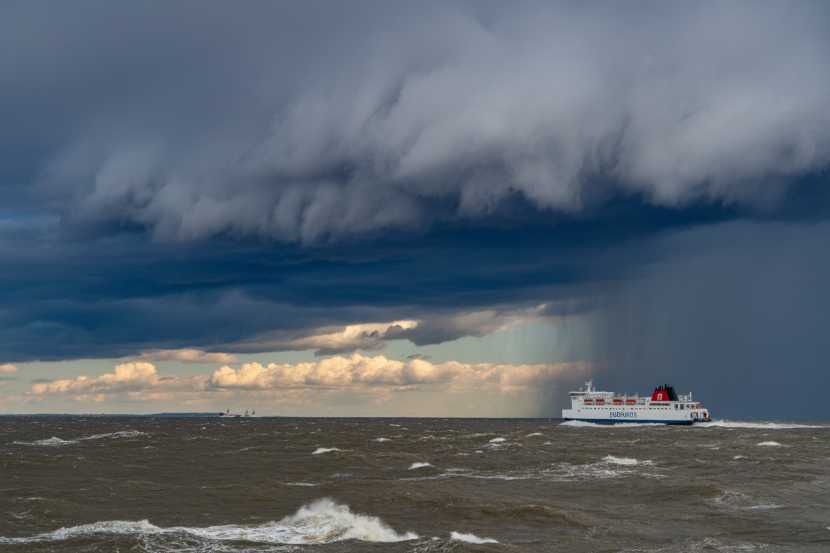Home » CRUISE NEWS » Powerful Storm Amy Disrupts Baltic Sea Ferries and Halts Travel Across Northern Germany
Published on
October 5, 2025
On Sunday, October 5, 2025, severe weather conditions caused by Storm Amy—known in Germany as Storm Detlef—severely impacted ferry services across northern Europe. The Baltic Sea route between Rostock in Germany and Gedser in Denmark, one of the busiest ferry crossings in the region, was completely cancelled for the day due to the storm’s intensity.
The storm led to high winds, strong gusts, and unpredictable seas that made ferry operations unsafe. Scandlines, the operator of the Gedser–Rostock route, took to their official website to announce the cancellations. According to the statement, all departures on Sunday were cancelled due to weather conditions, with the last ferry leaving at 18:00 on Saturday, October 4. The operator confirmed that services would return to normal on Monday, October 6, with the first departures scheduled at 01:45 from Gedser and 01:30 from Rostock.
Alternative Travel Options for Affected Passengers
As ferry services between Rostock and Gedser were temporarily suspended, Scandlines recommended passengers consider other available routes. One such alternative is the Rødby–Puttgarden ferry route, which remained unaffected by the storm. This route, which connects Rødby in Denmark with Puttgarden on the German island of Fehmarn, continued to operate without interruption, offering a viable option for travelers who were unable to use the Gedser–Rostock ferry.
Although the Rødby–Puttgarden route was operating as scheduled, passengers were urged to check live updates from the operators, as weather conditions could affect operations at short notice. Travelers were also reminded to stay informed through Scandlines’ official website and customer service channels for real-time updates on ferry schedules.
The Storm’s Broader Impact Across Northern Germany
While the Gedser–Rostock ferry service bore the brunt of the storm’s disruption, the effects of Storm Amy were felt across a wider area in northern Germany. The storm triggered warnings of coastal flooding and storm surges along the North Sea and Baltic Sea coastlines.
In particular, services to Germany’s North Sea islands were disrupted. On Saturday, October 4, ferry services to the Halligen islands were temporarily suspended, and on Sunday, October 5, they were completely cancelled between Schlüttsiel and the Halligen islands due to high winds and surging waves. Additionally, ferry services to the island of Sylt, a popular holiday destination, were also affected. Several crossings to Sylt were cancelled both on Saturday and Sunday because of flooding, making it difficult for travelers to access the island.
Storm Surges and Coastal Flooding
The German Meteorological Service (DWD) issued multiple warnings as the storm approached, predicting that some coastal areas could experience storm surges. These surges were expected to cause water levels to rise by as much as two meters above normal. Areas most at risk were along the North Sea coast, including Hamburg and Bremen. Local authorities had prepared for the potential of coastal flooding, and emergency services were on standby.
As part of the precautions, several communities along the coast took measures to ensure public safety. In some regions, authorities closed coastal pathways and advised residents to stay indoors during the storm’s peak. In the East Frisian coastal town of Harlesiel, all beach areas and campsites were evacuated as a preventive measure. Fortunately, the storm’s impact in Harlesiel was less severe than initially expected, and no major damage was reported.
Forecasted Wind Gusts and Squalls
The DWD predicted strong wind gusts reaching up to 85 kilometers per hour in some parts of northern Germany, with isolated squalls hitting speeds of 100 kilometers per hour. These intense gusts created hazardous conditions, particularly for the ferry routes. With the storm impacting both the North Sea and Baltic regions, ferry operators were forced to assess the safety of their vessels and cancel services accordingly.
While many ferry operators took proactive steps to inform passengers, travelers were still advised to exercise caution when traveling during the storm, particularly when navigating coastal areas. For those whose ferry plans were impacted by the storm, having contingency plans was essential in case services were delayed or cancelled.
Traveler Recommendations During Severe Weather Events
As Storm Amy continued to wreak havoc across northern Europe, it is important for travelers to follow official advice and make informed decisions regarding their travel plans. Whether crossing the Baltic Sea or the North Sea, passengers are encouraged to regularly check the websites of ferry operators for real-time updates on disruptions. For example, Scandlines provided detailed information on their website about the cancellations, including instructions on how to request refunds or rebook affected ferry crossings.
Travelers should also consider flexibility in their travel plans, allowing for potential changes due to the unpredictable nature of severe weather. Those traveling to and from the island destinations on the North Sea should keep in mind that weather conditions may change rapidly, requiring further adjustments to schedules. Authorities continue to monitor the storm’s progress, and all ferry companies operating in the region have updated their websites to reflect the most current information.
Looking Ahead After the Storm
While Storm Amy brought significant disruption to ferry services in northern Germany and Denmark, including the cancellation of several major ferry crossings, the situation is expected to improve starting Monday, October 6. Scandlines has confirmed that normal ferry schedules between Gedser and Rostock will resume with the early morning departures.
However, the event serves as a reminder of the potential for unpredictable weather in the region, especially during the autumn and winter months. As climate change continues to affect weather patterns, travelers can expect to encounter more severe storms in the future. For those planning to travel by ferry across northern Europe, it is critical to monitor weather forecasts, heed official warnings, and have backup plans in place in case of service interruptions.
